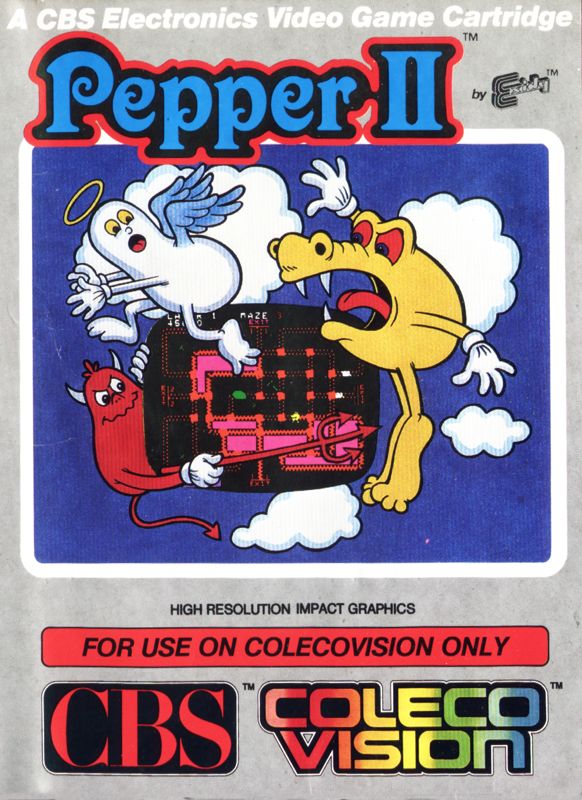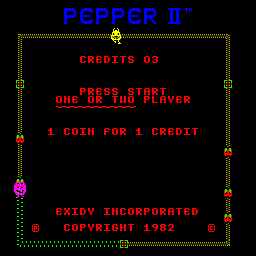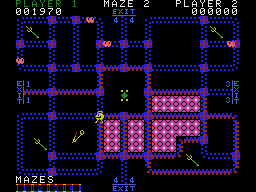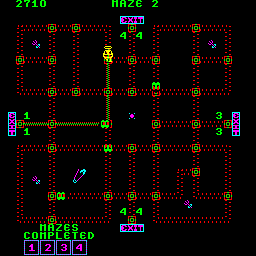Retro Replay Review
Gameplay
Pepper II delivers a deceptively simple premise that becomes increasingly addictive as you progress. The core mechanic revolves around “zipping” closed sections of the maze, and each completed segment fills with vibrant color. At first glance, the task seems straightforward – just navigate the corridors, seal them off, and move on. Yet, the moment you backtrack along an unfinished path, you risk unzipping your previously secured lines, forcing you to rethink your route and plan ahead.
The game structure consists of four distinct mazes per stage, and you can swiftly jump between them using the side, top, and bottom exits. This multi-maze design keeps the action fresh and encourages strategic movement. Do you finish one maze entirely before moving on, or do you dash through multiple areas to avoid pursuing enemies? Each choice impacts your success, making Pepper II a delightful exercise in risk versus reward.
Enemies patrol the corridors with increasing aggression as stages advance. One careless collision spells instant defeat, so quick reflexes are essential. To balance this, power-ups are hidden within certain zip-closed sections. Some grant temporary invincibility, allowing you to plow through foes unharmed; others clear the screen of baddies altogether. Timing these boosts can be the difference between survival and starting the maze anew.
As you climb through higher stages, the difficulty curve ramps up noticeably. Claustrophobic pathways, faster enemies, and trickier layouts demand sharper focus and faster decision-making. While this escalating challenge can feel unforgiving, it also fuels a powerful loop of “just one more try.” For fans of classic arcade puzzles, mastering Pepper II’s nuanced mechanics is a deeply rewarding experience.
Graphics
Pepper II embraces the minimalist charm of early 1980s arcade visuals. The mazes are composed of clear, straight lines and right angles, giving the game a crisp, geometric aesthetic. When you zip shut a section, the sudden burst of color provides instant visual feedback and a satisfying sense of progress. Though the palette is limited, the bright hues contrast beautifully against the black background, ensuring every move is easy to track.
The player character and enemies are rendered as simple sprites, but each has a distinct silhouette that’s always readable, even in the heat of frantic play. Enemy animations are basic—mostly simple direction changes and brief pauses—but this simplicity keeps the focus on fast-paced navigation rather than flashy effects. It’s a design philosophy that favors clarity and responsiveness over visual flare.
Stage transitions are swift, with a brief interlude showing your completed progress before jumping into the next set of mazes. This small but effective pacing break lets you catch your breath and mentally prepare for the fresh layouts. Power-up effects, like the screen-clearing animation, add excitement without overstaying their welcome, maintaining the game’s breakneck tempo.
While modern gamers might find the graphics rudimentary, there’s undeniable retro appeal here. Pepper II’s visuals capture the essence of arcade simplicity, where every color shift and sprite movement has a functional purpose. If you appreciate pure gameplay-first design and nostalgia for the golden age of arcades, these visuals hit the mark.
Story
Pepper II doesn’t offer a sprawling narrative or deep character arcs; instead, it delivers a straightforward arcade scenario. You play as the titular “Pepper,” tasked with zipping up all maze sections before time runs out and hostile creatures close in. This minimalist setup places full emphasis on gameplay mechanics rather than elaborate story beats.
The lack of a traditional storyline can be a welcome respite for players seeking pure, unadulterated challenge. There’s no need to slog through cutscenes or complicated lore—you pick up the joystick, dive into the first maze, and immediately engage with the core objective. The game’s identity is entirely wrapped up in its mechanics: color-filling, strategic zipping, and enemy avoidance.
That said, small touches hint at a broader world. The escalating maze designs convey a sense of journeying deeper into an increasingly hostile environment. Power-ups are thematically represented as technological boosts or wild “pepper bombs,” suggesting a playful sci-fi context. These hints of setting enrich the otherwise barebones presentation, adding just enough flavor to spark the imagination.
Ultimately, Pepper II’s story is one you craft through play. Each run tells a tale of narrow escapes, triumphant completions, and growing mastery. For many players, the emergent narrative of beating a particularly tough stage or discovering an efficient route is the most compelling story the game has to offer.
Overall Experience
Pepper II stands out as a testament to pure, unfiltered arcade action. Its blend of strategic maze navigation, precise timing, and escalating difficulty ensures that every session feels both challenging and rewarding. The learning curve is steep, but once you internalize the zipping mechanics and enemy patterns, the sense of accomplishment when clearing a stage is immense.
Replayability is a core strength. With no branching paths or multiple endings, the game’s longevity hinges on improving your performance and chasing higher stage records. This focus on mastery will resonate with players who thrive on perfecting patterns and shaving seconds off their best times. Every playthrough is an opportunity to tighten your routes and push deeper into the mazes.
While the audiovisual presentation is modest by modern standards, it perfectly complements the game’s rapid-fire gameplay. There’s no downtime, no fluff—just you, your reflexes, and a labyrinth groaning under the weight of incomplete zips. If you prize gameplay purity and have a soft spot for retro arcade sensibilities, Pepper II delivers an experience that’s easy to pick up yet devilishly hard to put down.
In a market crowded with sprawling narratives and photorealistic graphics, Pepper II’s straightforward maze challenge feels refreshingly focused. It’s a title that demands your attention, rewards your precision, and invites repeated attempts to conquer its ever-tightening grip. For anyone seeking a bite-sized but endlessly replayable arcade puzzle, Pepper II is well worth the space on your virtual shelf.
 Retro Replay Retro Replay gaming reviews, news, emulation, geek stuff and more!
Retro Replay Retro Replay gaming reviews, news, emulation, geek stuff and more!









Reviews
There are no reviews yet.